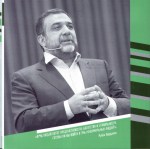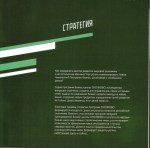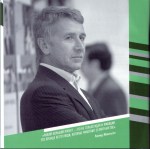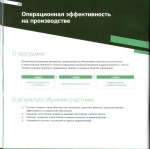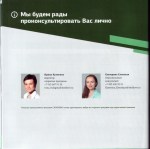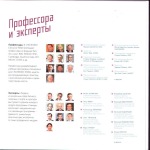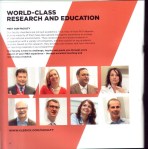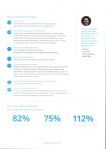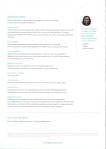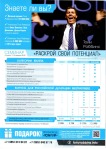Archive
Coursera: Georgia Institute of Technology
Georgia Institute of Technology
via coursera.org Platform
10.06.2018
Online Educational Course “Supply Chain Principles“
This course will provide a solid understanding of what a supply chain is all about. The course:
– Provides an introduction to Supply Chain
– Leverages graphics to promote the Integrated Supply Chain model
– Emphasizes understanding the Extended Supply Chain
– Presents a holistic approach – Incorporating People, Process, and Technology
– Calls-out industry-specific supply chain
– Leverages discussions, videos, quizzes, and questions for consideration
– Provides awareness of career path opportunities
– Presents emerging and futuristic trends in supply chain and given that at GT we are focused on developing what’s next in the world, we include Discussion of emerging and futuristic trends in supply chain.
There is very little math involved in this course – so don’t worry at all about your math skills.
The course incorporates reading materials that were developed as part of a $24.5M TAACCCT grant awarded by the U.S. Department of Labor’s Employment and Training Administration to the LINCS in Supply Chain Management consortium.
This course is designed for a wide range of learners including:
– Individuals working in a supply chain domain interested in improving their knowledge of supply chain
– Individuals curious about pursuing a career in supply chain
– Students working or studying in an adjacent business field
– Seasoned professionals who may be moving to a new area of supply chain
– Hobbyists – seeking to learn more about the world around them
Alison Platform
Alison
via Alison.com Platform
03.06.2018
Online Educational Course “Inventory Models – Costs, EOQ Model”
by G. Srinivasan
Inventory Management – Using Inventory Models is the fourth in the Applied Operations Management series of courses. Inventory models help businesses answer the questions: How much material to order? When to order the material? They help firms determine the order quantity that minimizes the total inventory holding costs and ordering costs, as well as the frequency of ordering, to keep goods or services flowing to the customer without interruption or delay.
The course begins by introducing the basics of inventory management and introduces concepts such as deterministic demand and probabilistic demand, type of costs such as cost of item, order cost, and holding or carrying cost. Several models are available to help determine how much inventory should be brought in to restock the products or parts, and you will be introduced to inventory models such as the single period inventory model, the multi-period inventory model and the economic order quantity (EOQ) model. These models are explained in detail using worked examples.
This course will be of great interest to professionals working in the area of inventory management, procurement and operations management and who would like to learn more about using inventory models. The course will also be of interest to learners who are interested in a career in procurement or operations management.
The key points from this module are:
Economic order quantity (EOQ) model is the order quantity that minimizes the total inventory holding costs and ordering costs.
Several extensions can be made to the EOQ model developed by Mr. Pankaj Mane, including backordering costs and multiple items.
The EOQ model solves the “how much” and “when” aspects of ordering inventory. When inventory reaches the zero point, you order just enough to replenish your stock back to its original level.
You repeat this cycle throughout the year, never having to decide when to order or how much to order.
The EOQ model assumes that demand remains steady throughout the year and that inventory gets used at a fixed rate. If those assumptions hold true, you can order at the same time each month or quarter.
However, if demand fluctuates, you may run out of inventory sooner than you anticipate. You also may have to order more than you usually do to meet higher demand, or lower the order to adjust to declining demand.
The EOQ will sometimes change as a result of quantity discounts, which are provided by some suppliers as an incentive for customers to place larger orders.
Score
Alison Platform
Alison
via Alison.com Platform
03.06.2018
Online Educational Course “Supply Chain Risk”
by N. Viswanadham
The course Understanding Supply Chain Risk Management (SCRM) introduces the learner to the multitude of risks that threaten the operation of supply chains at national and global levels. A previous course – Understanding Supply Chain Ecosystems – looked at Supply Chain Ecosystems and supply risk involves adverse and unexpected changes to any elements of a supply chain ecosystem.
The aim of SCRM is to reduce supply chain vulnerability by identifying and managing risks within the supply chain and external to it. The course gives examples of resource uncertainties, characteristics of Wicked problems, and describes the elements of a cyber attack. It also lists the six strategies to reduce overall risk exposure.
This course will be of great interest to all professionals who work in the areas of operations management, logistics, procurement and information technology, and to all learners who are interested in developing a career in the area of supply chain management.
Score
Alison Platform
Alison
via Alison.com Platform
03.06.2018
Online Educational Course “The Supply Chain Eco-System Framework”
by N. Viswanadham
Supply Chain Ecosystems are made up of a network of organizations, people, activities, information, and resources all of which are involved in moving a product or service from supplier to customer.
The course begins by describing how modern supply chains have evolved into complex international networks, which can no longer be adequately described using the linear concept of a ‘chain’. The course then reviews how modern supply chain ecosystems now comprise of a network of companies, countries and their governments, social and political organisations, natural, industrial (clusters), financial and human resources, delivery infrastructure including logistics and IT, and knowledge of the industrial environment. You will learn how within these ecosystems, each configuration is unique to the particular enterprise that owns that supply chain.
This course will be of great interest to all professionals who work in the areas of operations management, logistics, procurement and information technology, and to all learners who are interested in developing a career in the area of supply chain management.
The key points from this module are:
The Ecosystem Model: A framework to visualize all Operational, Strategic, Management and Execution issues.
Ecosystems comprise of a network of:
Companies, countries and their governments, Social and political organisations
Natural, Industrial (clusters) and Financial and Human resources
Delivery infrastructure including logistics and IT
Connections, and knowledge of the industrial environment.
All interacting together with the landscape and climate (economic and industrial).
Supply chain ecosystems consist of:
Institutions
Resources
Delivery Services infrastructure
Supply Chain
Institutions:
Customs, Export and Other Govt. Regulators
Quality Control and Environmental issues
Social, Financial and Trade issues
Resources:
Infrastructure, Sea ports, Airports, Roads
Industry clusters
Human, Financial and Natural resources and labor unions
Delivery Services infrastructure:
Logistics and IT companies
Transport – Rail, Air, Ship, Road
Logistics parks, SEZs, Freight corridors
Supply Chain:
Retail chains
Distribution
Manufacturing
SuppliersDrivers of Supply Chain Competitiveness
Resources: Labour, Materials and Energy
Government policies and investments on institutional, environmental and infrastructural elements
Delivery mechanisms: Logistics and IT
SES Framework can hep to study:
Governance
Risk
Innovation
Performance
The Five STERM Forces:
Science research
New Technologies
New Engineering materials
Regulations and policies
New Management techniques
Modular Product:
– Made by appropriately combining different modules.
– Provides customers a number of options for each module and thus the product.
– Products differ from each other in terms of the subsets of modules assembled to produce them.
Modular Process:
– Each module undergoes a specified set of operations making it possible to outsource its manufacturing and inventory to them in a semi-finished form.
Part Standardization:
– Common parts are used across many processes
– Products redesigned as necessary
Process Standardization:
– Standardizing as much of the process as possible, making a generic or family product.
– Final product assembly delayed until the customer order is received (i.e. called “postponement”).
Modular Organization Designs
Modularization of product designs paves the way for similar modularization of organization designs facilitting coordination of activities via an “information structure” rather than managerial authority or hierarchy.
The codification of knowledge and standardization (through technical standards and design rules) of the interfaces between organizationally separate stages of production has made vertical specialization (organizational modularity) replace vertical integration.
Types of Resources
Classical economics define:>
– Natural resources
– Human resources
– Financial resources
– Capital assets
Modern view also includes:
– Knowledge, Intellectual property
– Social capital relationships with stake holders
– Management of high value delivery processes
Special Economic Zones (SEZs)
SEZ is a geographical region that has economic laws different from the rest of the country. The goal of SEZs is to attract foreign investments. SEZs have been established in many countries – China, India, Jordan, Poland, Philippines, Russia and North Korea. Indian SEZs are not as effective as those in China probably because they are not as focused.
Clusters
Clusters are geographic concentrations of interconnected companies, specialized suppliers, service providers, and associated institutions (universities, training) in a particular vertical.
Clusters allow companies to operate more productively in sourcing inputs; accessing inforamtion, technology and human resources.
Score
MBA Boutique Event MBA25
MBA Boutique Event MBA25
26.09.2015
Moscow, Russia, Swissotel Krasnye Holmy, Kosmodamianskaya nab., 52 bld. 6
MBA25 is the unique MBA Boutique Event connecting best world business schools with high-caliber candidates. Only TOP schools. Only TOP candidates.
Program:
Application workshop
TOPIC: “Your way to Top Business School”
Panel Discussion with Experts
TOPIC: “MBA and Financing Issues”
Panel Discussion with Business Schools’ Representatives
Round Tables with Business Schools’ Representatives and Alumni
Stanford, Wharton, MIT, IE, INSEAD, Yale, Columbia Business School, London Business School, Kellogg School of Management, IESE Business School, Manchester Business School, Duke Fuqua School of Business, Darden, SDA Bocconi, ESMT, Nanyang Business School, NUS, HKUST and Boston Consulting Group
Photos:
Materials:
MBA25 Catalogue
MBA Strategy
Skolkovo Business School of Management




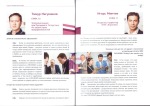






The New Economic School

Vlerick Business School
Prodigy Finance
Nordic Business Forum
Tony Robbins Events
Contacts
Tino Elgner. Senior Associate Director of Admissions. IE Business School. Spain
Sarah Bishop. Business Development. Prodigy Finance. UK
www.procurementsense.com
11.01.2014
Links: Page
The article “Crowdsourcing Model of Company Management: Implementation Mechanism, Advantages and Disadvantages”
The article proposes a crowdsourcing model of company management with a description of the initial stages of task development for crowdsourcing project consulting support, task forming for the project on the Internet, proposed solutions evaluating to the possibility of company using. It also describes the advantages and disadvantages of this model and also a technique of selection of useful solutions.































































































